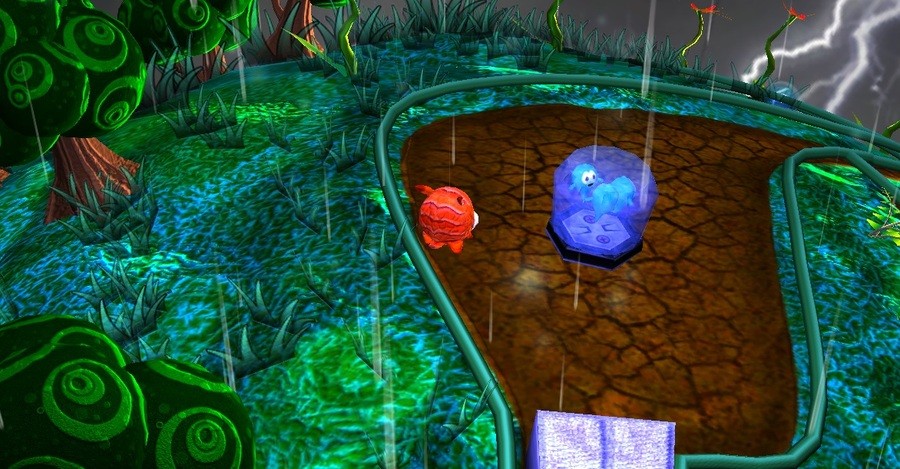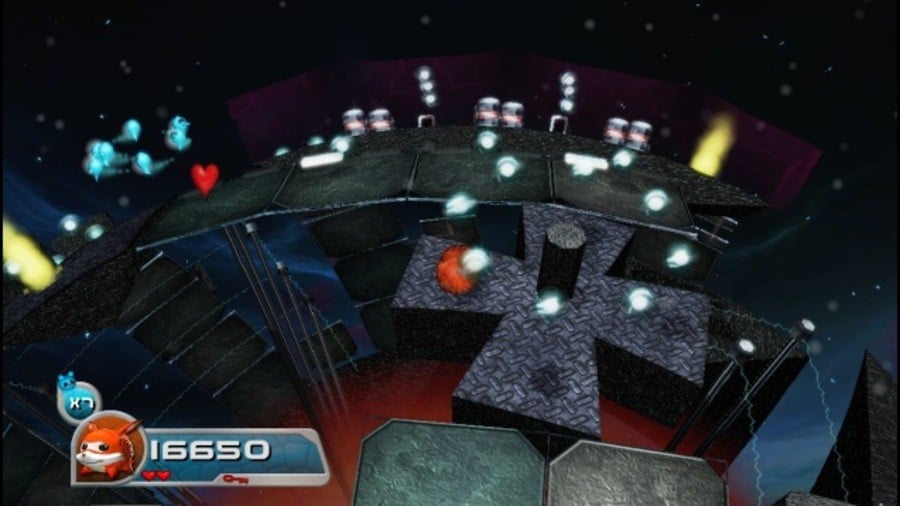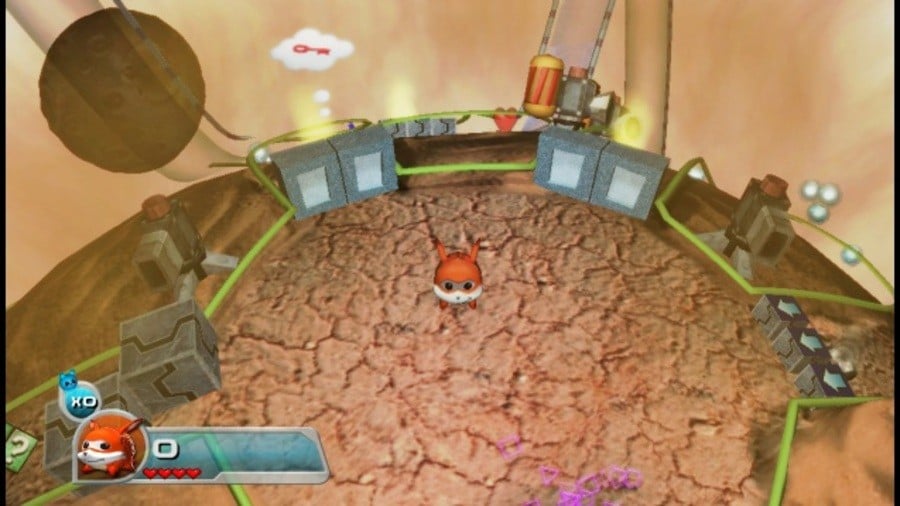
Yesterday we exclusively broke the news that Fuzzy Wuzzy Games' Armillo is coming to the Wii U eShop. Keen to know more about the development and history of this interesting title, we sat down with James Saito and Yanni Fyssas for a little chat.
Nintendo Life: Can you give us a bit of information on your respective backgrounds and previous experience?
James: Prior to Fuzzy Wuzzy Games, I was first working as a tools engineer, and then gameplay engineer at EA for 7 years. Prior to that, I worked as a hobby programmer since I was 8 years old. My first computer was an Amiga 500 and one of the first things that I did on that was programming. I was hooked into programming because of Nintendo. My first taste of video games was when I visited Japan over a year before Nintendo released the NES in North America. It was a Famicom System at my cousin’s place. I just couldn’t stop thinking about Super Mario Bros.. Imagine my excitement when I saw that it finally came to North America. Right now, Armillo is my night time job, but I’m spending about full time on it each week. During the day, I am working under contract for an indie company called Nine Tail Studios.
Yanni: I started playing guitar at 7 and audio recording at 14. Video games kicked in at 10 and I bought a Vectrex with paper route money at 13. The paper route paid barely anything so it took a looooong time to amass enough money for the Vectrex. By the time I was 19, I had recorded and mixed band demos on amateur equipment, built a small studio, and recorded at other local studios as a session guitarist. After 10 years of professional studio work as a recording/mixing engineer, I moved over to games and worked at Electronic Arts as a Sound Designer. I’m now a freelance Sound Designer focusing on games, but at my studio Hybrid Soundworks. I also work on films and music mixing/mastering.
Nintendo Life: Can you describe the appeal of Armillo for us?
James: It’s a fun, fast-paced 3D platformer. I would say that the main appeal would be its defined obstacle course style design with many short challenges sequenced together to form a level. It keeps the gameplay interesting through the variation of mechanics. It's also a nice throwback to past games. It's got the speed, the shooting, exploding, and platforming.
Yanni: Balanced gameplay, some puzzles, interesting visuals and a cute character. Most test subjects (err, I mean players) have reported back saying it’s a ton of fun, especially the local multiplayer co-op mode.
Nintendo Life: When did development on Armillo begin?
James: We started development around the beginning of 2011. Around the beginning of 2012 is when we decided that we wouldn't rush the game to completion and instead take our time to make this as good as we can. We also paused development for a few months in 2012 just to take a step back and analyze the game as a whole to make it much better. But just prior to that, I almost gave up on its development and just wanted to release a watered-down version. But my fellow team members encouraged me not to and focus on a quality game. Looking back, I’m glad that I didn’t go down that route.

Nintendo Life: Did any games provide direct inspiration for Armillo?
James: Yes, Super Mario Galaxy and Marble Madness are a couple of games with direct influences. Marble Madness influenced more of the rolling and obstacle course style gameplay. Mario Galaxy more on the gameplay mechanic where you roll around the sphere. Interestingly, despite myself being the Nintendo fan of the group, it was our 3D Artist’s idea to go this route with the spherical gameplay. What’s also interesting is that Sonic comes up a lot when comparisons are made to our game, since our game is also about being fast and has similar controls. But none of us in the team are really Sonic fans and didn’t realize the similarity until much later in development. On a side note, it is also interesting how Armillo’s eyes have a direct resemblance to Sonic’s eyes. At one point, our Artist wanted to design his eyes to look different and unique and drew those eyes. None of us in our team realized the similarity until later, but we ended up printing a lot of press material by then so we decided to keep it like that.
Yanni: I haven’t played Sonic a whole lot but at PAX11, people kept bringing it up. I wanted to create a frantic sense of speed at times, so I think that’s a definitely a common thread between Armillo and Sonic. Who doesn’t like rolling around and going mega fast? I think working on Need For Speed while at EA and chatting with Charles Deenen also instilled in me the importance of a sense of speed, and how it can drive gameplay, so that concept probably comes through somewhat in this game.
Nintendo Life: Is it true that the game was originally intended for XBLA? Is that version still in development?
James: Yes, in a way. If you go all the way back to the origins of the game, it was initially meant to be a simple mobile game. It too was also prototyped in XNA. However, the game changed. It went from 2D to simple 3D, then to 3D with large worlds. We still stuck with XNA and decided instead to go the console/PC route, so by technicality we decided to aim for XBLA. Fast forward to today, the XNA version is no longer in development. But even with Unity, the potential on releasing on XBLA still exists as Unity supports XBLA. Of course, the downside is that we can’t release the Unity build version on Xbox Live Indie Games.
Nintendo Life: What made you pick Wii U as a potential platform for the game?
James: There was one point early in the development I thought about the original Wii, but after hearing about its limitations - especially with memory, performance, and game size limit - I just couldn’t see it as a viable platform for Armillo. For some reason, I never really put too much thought into the Wii U. It’s an interesting story how it became a reality. After our development break, I decided to open up to the community and started writing development blogs on IndieDB. At one point, someone posted a comment and asked if our game will ever see an XBLA release, so I replied talking about our pitch to Microsoft and how they’d decided to pass on us as our type of game generally does not have much of a sales impact on their market. So press member Emily Rogers sent an e-mail to us, referring us to that comment and asking us if we were interested in getting our game to the Wii U instead. Our initial thought was more along the lines of how are we going to port our XNA game to the Wii U? Then Emily brought up the information that Unity will be ported to the Wii U. And then I was sold. Of course, we still had to go through the approval process to become official Nintendo developers.

Nintendo Life: How easy has it been porting the game from XNA to Unity?
James: It’s not too bad. Prior to porting the game to Unity, I’d already had over half a year of experience working with Unity so I was able to lay out the design of the port before I started. One benefit is that both XNA and Unity support C#, so there was very minimal syntax changes to the code that I needed to port. I’ve decided to do an incremental port, meaning that I would take the game piece by piece and selectively port it in order to get a much smaller subset of the game initially working rather than trying to port the whole game all at once. That way, I was able to clean up a lot of the game’s code for easier maintenance and the code style would be more tailored towards Unity’s infrastructure. We're about a month in now and a good majority of functionality is now in. I ended up porting a majority of the gameplay mechanics, scrapping the entire rendering code in favor of Unity’s built-in system, and rewrote the entire front-end (menu) system, procedural mesh generation, and particle/effects system. Since then, I’ve added a new weather effects system that wasn’t present in the XNA version. All of our 3D models were in a format that both Unity and XNA supported, so they just worked.
Yanni: The audio port can be a daunting task with over 900 sounds (and counting) but it’s also fun ride! I’ve spent a long time talking to other sound designers about the pros and cons of audio middleware like fmod, Wwise and Fabric 2.0. In a way, the Audio tools we got from XNA were really fantastic and this allowed me to really stretch the audio, design and real time mixing for Armillo. Replicating this will be challenging in Unity, but who doesn’t like a good challenge?
Nintendo Life: What's it been like working with Nintendo? How supportive has the company been?
James: So far, we’ve just been through the approval process and it has been very straightforward and the approval process was quick and easy. Total smooth sailing, so no complaints here!
Yanni: I think it’s pretty obvious Nintendo have made a conscious decision to empower the Indies on this platform. I hope they are as successful with the Wii U as they were with the Wii hardware.
Nintendo Life: Have you had any contact with Dan Adelman?
James: Yes! He is our main point of contact with Nintendo. He’s this super-friendly guy who goes the extra mile to make things work for us. One day, I sent him an e-mail pitching our game, the next day he responds, and the following day I’m on the phone with him, answering all my questions and describing me their excellent development process. He’s really committed towards making sure that Nintendo is doing their best to reach out for Indies.
Nintendo Life: What's your opinion of the Wii U itself? Is it as powerful as you'd want? Is it easy to develop for?
James: I do have to admit that I haven't bought a Wii U yet as I no longer buy consoles at launch ever since I’ve started a family, and I have another kid on the way as well. But for sure I’ll be getting the Wii U as I’m a huge Mario fan and the New Super Mario Bros. U is probably the only Nintendo made Mario platformer that I have yet to play. And I love the concept of the second screen, especially with the ability to play the game just on the screen itself. We don’t have dev kits yet, but basing on technical specs - processing power and RAM - it’s more than plenty. Armillo isn’t exactly a graphical powerhouse when it comes to pushing polygons, and Unity has a pretty optimized rendering engine. Also with Unity support, we’re expecting developing for the Wii U to be pretty easy.

Nintendo Life: Do you have any other Wii U projects in development?
James: Yes, but nothing official yet that we want to announce. One project has been in the planning stages for a few months and will soon approach prototyping. I won’t say anything except that it’s going to be unique in its own ways, instead of being more of a throwback like Armillo. But for now, our focus is on finishing Armillo and making it as good as we’d like.
Nintendo Life: Do you think it's possible that the Wii U eShop could become as popular with indie developers as XBLA, Steam and PSN?
James: I think it is possible. Personally, I don’t have experience with working on PSN so I cannot comment on that. But with XBLA and its lengthy turnaround time and strict vetting process and Steam with its Greenlight process, I am hoping that the Wii U eShop will become even more popular with its faster turnaround time and far less restrictions on the developer. We’ll see!
Yanni: I think there’s a lot of potential and since Nintendo seems to be really listening to Indies, the potential is there for the eShop to grow and compete with XBLA.
Thanks to James and Yanni for taking the time to talk with us, and thanks to Emily Rogers for arranging the interview.





Comments 18
Good luck to both of them. It sounds like the game's still some way off, which is a shame: if it released in the next six months it would most likely be the first 3D platformer on the Wii U and would sell a lot by default.
It's also good to hear again how much Nintendo is reaching out to indie developers and supporting them. I just hope similar efforts are being made with the bigger studios.
Nintendo seems to be making some good choices in their courting of indie developers. That makes me very happy. Hopefully they can keep this up.
That Unity thing is really helping Nintendo with the indies.
Looks fantastic
Never heard of this game before, but it looks great from the screen shots and anyone willing to work with Nintendo to put there games on Eshop are OK on my book! Best of luck for them!
Good to see indie of a huge variety are embracing the eshop.
I hope the game is as fun as it looks, because I'd really like to support these guys.
I been interested in this game since I saw It on greenlight so it's nice to know it will have a definite release now.
I think indies are a good hedge against 3rd party publisher support and frankly I'd rather buy a quality indie game than a franchise entry from EA or Activison if they're only going to offer token support to Nintendo. In many ways it's like we're back in the days when computer games were made by bedroom coders. Hopefully Jeff Minter will join the Wii U party!
On-topic this sounds like a decent game - any developer putting time into making a quality product at least deserves a look, so we'll hopefully see the fruits of their labours soon.
Dude, I want this game! This looks awesome! Can't wait for this game to come out!
This game looks fun! Gonna try it out!
I loved marble madness for the original. This has the same feel. can't wait to download this!
This game looks wonderful. This interview has made me really look forward to it. I'm excited. Glad Nintendo is reaching out to more indie developers. It's really paying off!
Thanks for the interview, I really enjor them. Keep'em comin'!
The game looks promising, I'll keep an eye on it. I hope many indies choose WiiU to release their games.
Definitely positive news here! I think there's a large possibility that Wii U will be a haven for indie developers!
Hi, Nintendolife. After following this website for quite some while I finally decided to create my own account. I really enjoy this page because the gamers that make up this community are mature and they are able to have a good discussion about games. I hope that I could be accepted into your circle.
@SamSan37 Hello
__________________________
This looks like a fun game. It sounds like the devs are putting some love into it.
Looking forward to this and other indie releases for the Wii U.
Thanks for the article Damien. Good read.
I personally love all the indie games coming out on eshop. I've already bought three of them. I'm waiting on toki 2 and the pinball game... hope this game comes out soon!
Tap here to load 18 comments
Leave A Comment
Hold on there, you need to login to post a comment...